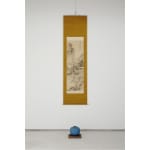Takahashi Sōhei (1804–1835)
Winter Hermitage
Color on silk, hanging scroll
With box authentication by Tanomura Chokunyu (1899), double boxed
Important Art Object
Seals: Tojin Tengai; Shoshaku Hankun
107 x 36 cm
188 x 51 cm (overall)
With box authentication by Tanomura Chokunyu (1899), double boxed
Important Art Object
Seals: Tojin Tengai; Shoshaku Hankun
107 x 36 cm
188 x 51 cm (overall)
Further images
Provenance
Collection of Korenori KiyotsuguCollection of Matsumoto Soken’an
Literature
Soken’an kansho (Chu kan). Osaka: Matsumoto Soken’an, 1923.Kokka no. 409. Kokkasha, 1924.
Togari Soshin’an, ed. Soken’an bijutsu shusei zuroku. Tokyo: Daiichi Shobo, 1933.
The painter Tanomura Chokunyu (1814–1907) inscribed the storage box for this hanging scroll with the characters “Winter Hermitage” in 1899. The art journal Kokka volume 409, however, mentioned this painting with the title Library of the Three Friends in 1924. Perhaps the words “Winter” and “Three Friends” allude to pine, bamboo, and plum, which are known for resisting the cold and thus symbolize the integrity and honor of virtuous men who overcome adversities. They also signify auspiciousness in Japan, and the inclusion of cranes here makes this painting all the more propitious.
The twisting trunk of the pine tree in the foreground is distinctive, though similar trees can also be found in Takahashi Sohei’s Reading in Autumn Wind (in Kokka, no. 757) and Seeking Plums above the Valley (Idemitsu Museum of Arts) as well as in Lan Ying’s (1585–1664) Landscape (Comprehensive Illustrated Catalog of Chinese Paintings, JP12-111). The development of such expressions likely came from the great influence of Lan Ying on Japanese literati painters.
Seeking Plums above the Valley and the present painting share several common features. Though it lacks pine trees, Seeking Plums above the Valley also has bamboo and plum trees in the foreground. Both paintings depict a nearly identical hermitage on a stone foundation. These similarities suggest that they date to around the same period. Seeking Plums above the Valley is dated to the second month of 1831, while the present work with its intensely twisted tree is inscribed with the characters, “three days before the end of the year,” indicating that it was likely painted on the twenty-seventh day of the twelfth month of 1831. Sohei began living in Osaka around the fourth month of that year, though his inscription reads, “From the south window of the guest house,” informing us that he did not paint this work at his home, which he called “beautiful place in one’s heart.”
Takahashi Sohei (painter; 1804−1835)
Also known as U; Genkitsu; Motoyoshi; Takumin; Kanmin.
Bungo-born late Edo period nanga painter. Had been interested in painting since his youth, and studied under the painter Tanomura Chikuden. Died at thirty-two, his artistic talent flowered and withered at an early age.
The twisting trunk of the pine tree in the foreground is distinctive, though similar trees can also be found in Takahashi Sohei’s Reading in Autumn Wind (in Kokka, no. 757) and Seeking Plums above the Valley (Idemitsu Museum of Arts) as well as in Lan Ying’s (1585–1664) Landscape (Comprehensive Illustrated Catalog of Chinese Paintings, JP12-111). The development of such expressions likely came from the great influence of Lan Ying on Japanese literati painters.
Seeking Plums above the Valley and the present painting share several common features. Though it lacks pine trees, Seeking Plums above the Valley also has bamboo and plum trees in the foreground. Both paintings depict a nearly identical hermitage on a stone foundation. These similarities suggest that they date to around the same period. Seeking Plums above the Valley is dated to the second month of 1831, while the present work with its intensely twisted tree is inscribed with the characters, “three days before the end of the year,” indicating that it was likely painted on the twenty-seventh day of the twelfth month of 1831. Sohei began living in Osaka around the fourth month of that year, though his inscription reads, “From the south window of the guest house,” informing us that he did not paint this work at his home, which he called “beautiful place in one’s heart.”
Takahashi Sohei (painter; 1804−1835)
Also known as U; Genkitsu; Motoyoshi; Takumin; Kanmin.
Bungo-born late Edo period nanga painter. Had been interested in painting since his youth, and studied under the painter Tanomura Chikuden. Died at thirty-two, his artistic talent flowered and withered at an early age.













